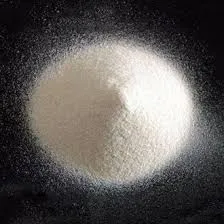
Sep . 30, 2024 12:09 Back to list
Effect of Hydroxyethyl Cellulose Concentration on Viscosity and Performance Properties
Understanding Hydroxyethyl Cellulose Viscosity Properties and Applications
Hydroxyethyl cellulose (HEC) is a non-ionic, water-soluble polymer derived from cellulose. Its unique chemical structure allows HEC to effectively increase the viscosity of aqueous solutions, making it a widely utilized thickening agent and stabilizer in various industries. This article will explore the factors influencing the viscosity of HEC, its applications, and the importance of viscosity in product formulation.
Chemical Structure and Properties
HEC is produced by the etherification of cellulose with ethylene oxide. The introduction of hydroxyethyl groups enhances the solubility of the cellulose polymer in water and contributes to its thickening properties. The degree of substitution (DS)—the average number of hydroxyethyl groups per anhydroglucose unit in the cellulose molecule—plays a crucial role in determining the viscosity of HEC solutions. Higher DS leads to greater viscosity due to an increase in hydrophilicity and intermolecular interactions.
The viscosity of HEC is also influenced by several environmental factors, including temperature, pH, and concentration. As the temperature increases, the viscosity of HEC solutions typically decreases due to reduced intermolecular interactions. Conversely, at lower temperatures, the viscosity increases as hydrogen bonding among the polymer chains becomes pronounced. Additionally, the pH of the solution can either enhance or inhibit the viscosity depending on the ionization of the hydroxyl groups, impacting the hydrogen bonding and hydration characteristics of the polymer.
Measurement of Viscosity
Viscosity measurement is critical in the characterization of HEC, especially since its applications often require specific rheological properties. The most common method for evaluating viscosity is using a viscometer, which can measure the resistance of the fluid flow. There are several types of viscometers, including rotational and capillary viscometers, each with its own advantages depending on the required viscosity range and application.
When measuring the viscosity of HEC solutions, it’s essential to consider the concentration of the polymer, as viscosity increases with concentration. Typical concentrations range from 0.5% to 5%, but formulations can vary widely depending on the desired application. It is also vital to allow the solution to hydrate adequately, as incomplete hydration can lead to misleading viscosity readings.
hydroxyethyl cellulose viscosity

Applications of Hydroxyethyl Cellulose
HEC finds extensive use across multiple industries thanks to its versatile properties
1. Cosmetics and Personal Care In the cosmetic industry, HEC is often used as a thickening agent in creams, lotions, and gels. Its ability to provide a smooth feel and stabilize emulsions makes it a preferred ingredient in many formulations. Additionally, HEC improves the aesthetic appearance of products, allowing for ease of application.
2. Pharmaceuticals HEC serves as a binder, film former, and controlled-release agent in pharmaceutical formulations. Its viscosity characteristics ensure uniform distribution of active ingredients, enhancing drug efficacy. Moreover, HEC can also be used in topical formulations for its soothing properties.
3. Food Industry In food applications, HEC is employed as a thickener and stabilizer in products such as sauces, dressings, and dairy items. Its ability to retain water helps improve texture and shelf-life while maintaining product quality.
4. Construction and Coatings HEC is used in cement and mortar formulations, providing improved workability and consistency. In paints and coatings, it helps maintain the desired viscosity and stability, ensuring even application and reducing sedimentation.
Conclusion
Hydroxyethyl cellulose is a critical ingredient in a multitude of applications due to its significant thickening and stabilizing properties. The interplay between its chemical structure, concentration, and environmental factors significantly impacts its viscosity. Understanding and controlling the viscosity of HEC solutions is essential for formulators aiming to create high-quality products across various industries. As research continues to expand the applications of HEC, its importance in product development and formulation will only grow, providing innovative solutions for consumer needs. The role of viscosity remains paramount in ensuring that HEC delivers its intended benefits effectively and efficiently.
-
The Widespread Application of Redispersible Powder in Construction and Building Materials
NewsMay.16,2025
-
The Widespread Application of Hpmc in the Detergent Industry
NewsMay.16,2025
-
The Main Applications of Hydroxyethyl Cellulose in Paints and Coatings
NewsMay.16,2025
-
Mortar Bonding Agent: the Key to Enhancing the Adhesion Between New and Old Mortar Layers and Between Mortar and Different Substrates
NewsMay.16,2025
-
HPMC: Application as a thickener and excipient
NewsMay.16,2025
-
Hec Cellulose Cellulose: Multi functional dispersants and high-efficiency thickeners
NewsMay.16,2025







